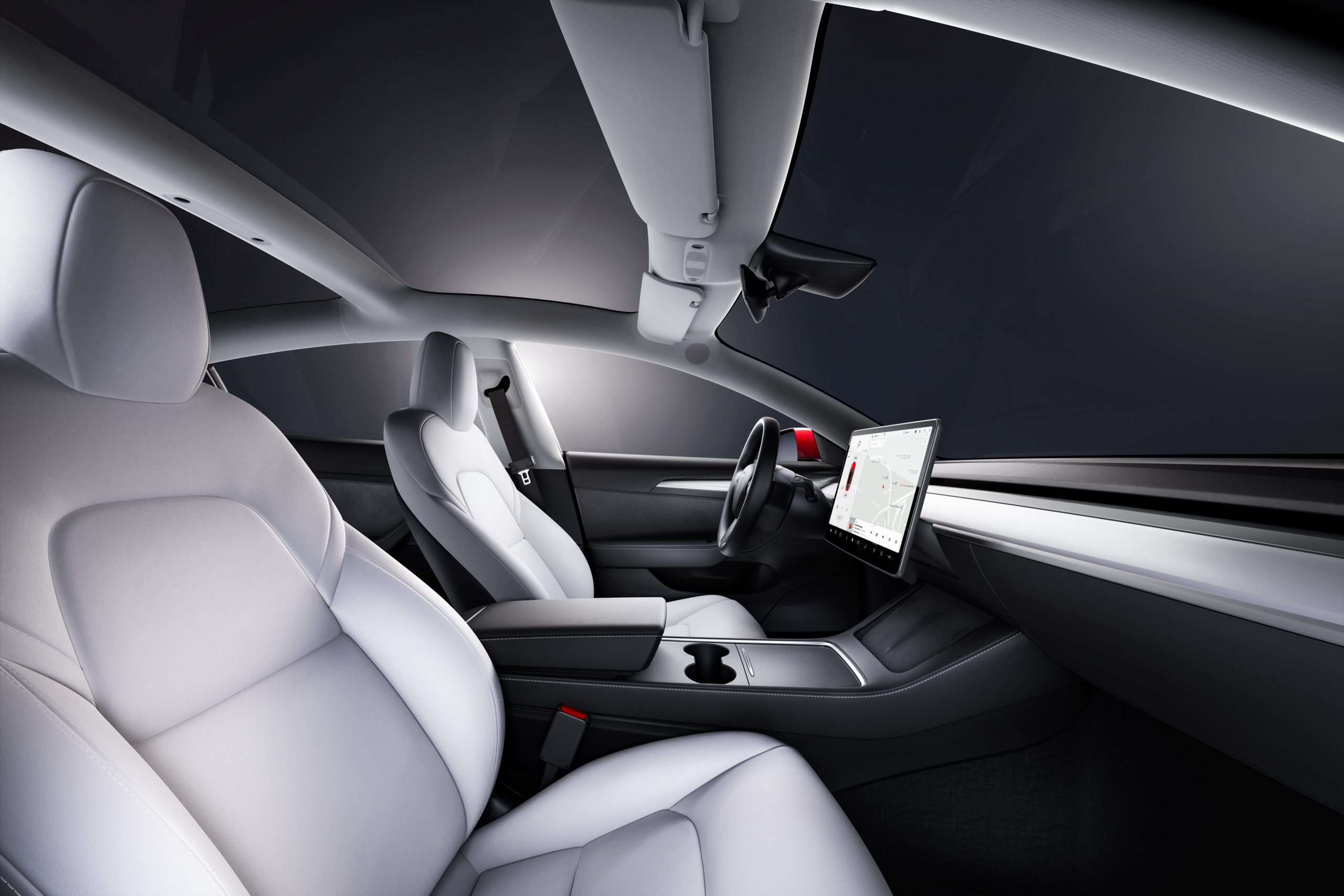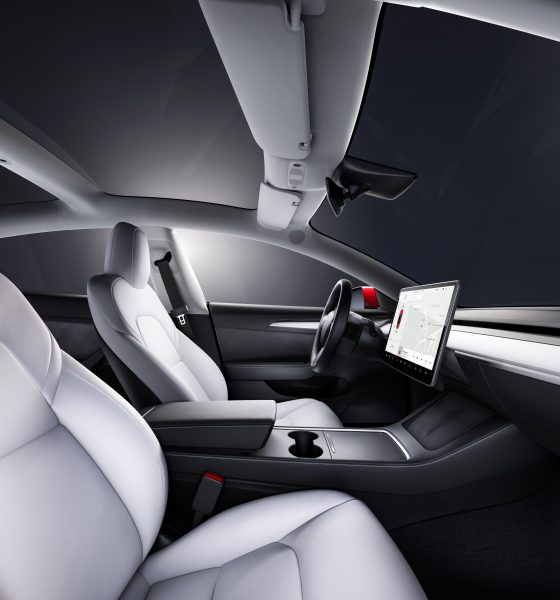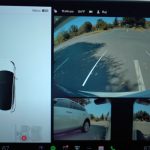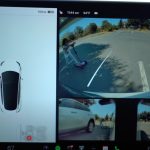Tesla has some of the most technologically advanced and sustainable vehicles consumers can buy on the market today. However, as Tesla Raj notes in one of his newest videos, his Tesla Model 3, along with other vehicles in the company’s lineup, are missing some of the most basic features that are available on models from other companies that are several years old. This begs the question: Would Tesla vehicles be even better with the five basic features Raj requests?
Cross-Traffic Alert System
One of the most important features that Raj lists is the Cross-Traffic Alert System. Noting that his wife’s 2016 Toyota RAV4 Hybrid has the system, which is highly effective in alerting the driver of an oncoming obstacle that is out of sight, Raj said his Model 3 lacks this somewhat basic safety feature.
While the Model 3 does offer wide-angle views from both rear quarter panels that could assist in a little more of a view, it still does not utilize any sort of system to sense objects, people, or vehicles that may be moving toward the Model 3. In a crowded Supermarket parking lot, Cross-Traffic Alert Systems are highly effective in keeping the driver vigilant as others look for a spot or shoppers head in or out of the store, perhaps with a heavy cart full of food. This simple addition could keep the car undamaged and could even save a life. Raj’s daughter, who was riding a scooter in the demonstration, was below the vehicles on either side of the Tesla. She was impossible to see until she entered the vehicle’s repeater camera view, which would likely give the driver a fraction-of-a-fraction of a second to stop.
As you can see in the pictures below, smaller obstacles, like shopping carts, as well as small children, are hidden by the vehicles parked next to Raj’s Model 3. A child is not seen until they are right behind the vehicle. These would be solved with basic sensors, which Tesla already has installed in their vehicles.
- The Tesla Model 3’s rear-view cameras lack a Cross-Traffic Alert System, which would help drivers see smaller obstacles that could be hidden by nearby vehicles (Credit: Tesla Raj)
- The Tesla Model 3’s rear-view cameras lack a Cross-Traffic Alert System, which would help drivers see smaller obstacles that could be hidden by nearby vehicles (Credit: Tesla Raj)
360-Degree Camera Views
Raj’s wife’s 2016 RAV4 Hybrid also equips a 360-degree camera, which the Model 3 also lacks. In October 2020, Tesla CEO Elon Musk confirmed that a Birds-Eye, 360-degree view of the vehicle would be coming with Full Self-Driving. It has not been released with the current iteration of Tesla’s semi-autonomous driving program, but Musk may have meant that the feature would not be released until FSD is actually complete, which would activate the company’s plans for a Robotaxi Fleet. However, so many vehicles have this feature already, which would activate full-range views of every obstacle around the car. The wide-range perspective would even help complement the previously-mentioned Cross-Traffic Alert System.
Vector-space bird’s eye view coming with FSD
— Elon Musk (@elonmusk) October 3, 2020
Tesla does offer those repeater cameras to help with a wider view of the car. However, they do not show a Birds-Eye angle, nor do they show the sides of the car.
Apple Music + CarPlay
If you follow Raj and Elon Musk on Twitter, you will know that Raj has requested the Tesla CEO to add this feature on many occasions, and for good reasons. While Tesla does currently offer Spotify, the world’s largest streaming platform for music and podcasts, and Tidal, another streaming app, the cars do not feature Apple Music support. Spotify does offer high-quality streaming, granted you are connected to a network that can support high download speeds. Tesla’s sound system, which has been noted as high quality by many, including Musk himself (surprise, surprise), is not getting used to its full capabilities without high-quality streaming services.
Apple Music supports Dolby Atmos’ spatial audio, which allows for high-quality streaming.
It would also support a lot of Tesla owners, as a poll Raj conducted showed 74 percent of the 2,292 votes received came from Apple owners utilizing iOS.
Tesla Owners what operating system is on your phone?
— Tesla Raj (@tesla_raj) July 28, 2022
Apple’s CarPlay is also highly intuitive, easy to use, and is supported by most automotive brands. I’m not sure if this comes down to some tech-based rivalry or just the fact that Tesla is not willing to license Apple’s software, but it would be a huge upside if these features were compatible with the vehicle.
Ease of Access to the Frunk
The lack of an engine in electric vehicles allows the Frunk – or Front Trunk – to exist. It gives owners just a little bit more room to store things like luggage or groceries, and it varies from vehicle to vehicle. The F-150 Lightning, for example, has a sizeable Frunk, basically adding a sedan-sized trunk to the already large bed area.
Ford F-150 Lightning unveiled: Price, Release date, Range, Features and more
The Model 3 Frunk is not easy to access, at least in Raj’s opinion. He would like to see an exterior Frunk access button or sensor that could remove the need to open the hood with the Tesla App or from the interior touch screen. Some vehicles have a sensor for trunks located underneath the rear bumper. It can be tapped with a foot to open and comes in handy when your hands might be full of groceries.
Tesla Model 3 frunk cargo space [Source: PTFI via Twitter]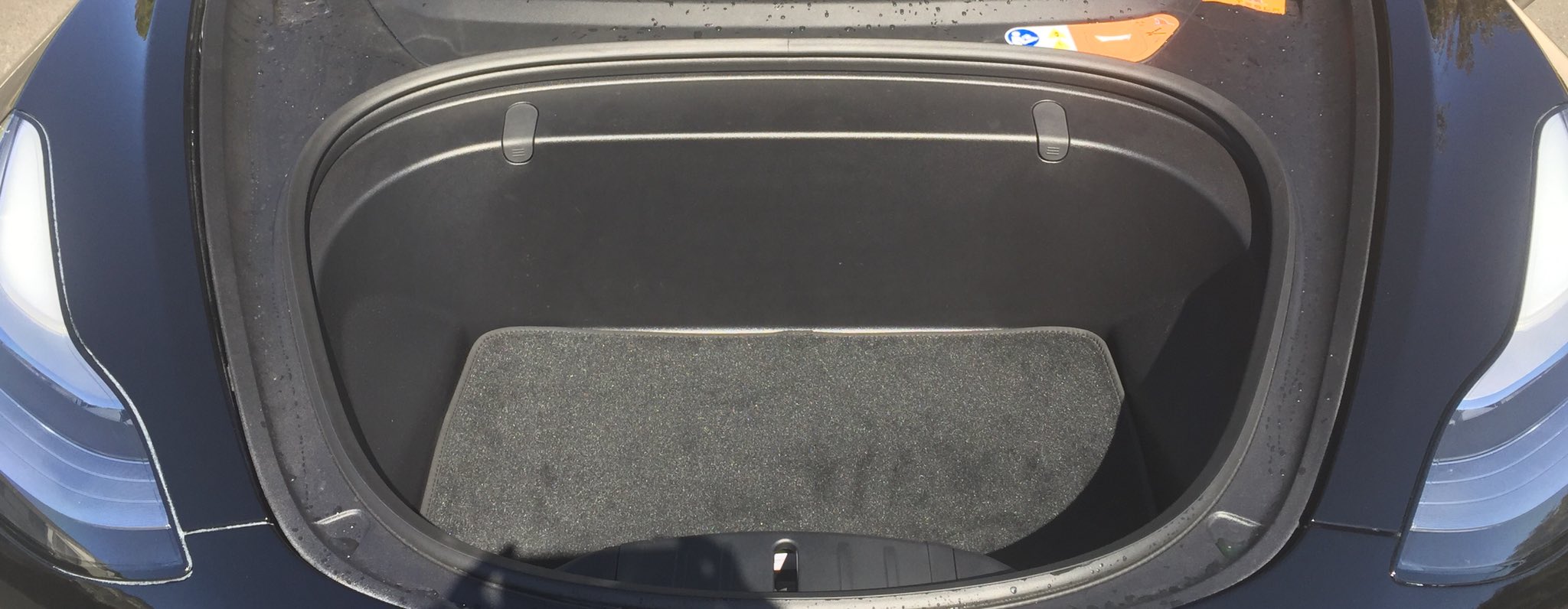
The Frunk is one of the most underrated parts of an electric vehicle, in my opinion. It should be easier to access, and you should not need a screen to do so.
Fleet-based User Generated Content
This is perhaps one of the most practical ideas Raj included in his video and is something that navigation apps like Waze and Apple Maps have included in their platforms. Alerting other drivers of hazards, police, accidents, stoppages, and other important occurrences on the road would be ideal to share between Tesla drivers. Reporting things like road debris or an officer shooting radar would most certainly be advantageous to the safety of drivers. It has allowed people to communicate with road conditions and is constantly updated by asking future drivers whether the hazard or obstacle is still present.
Credit: Apple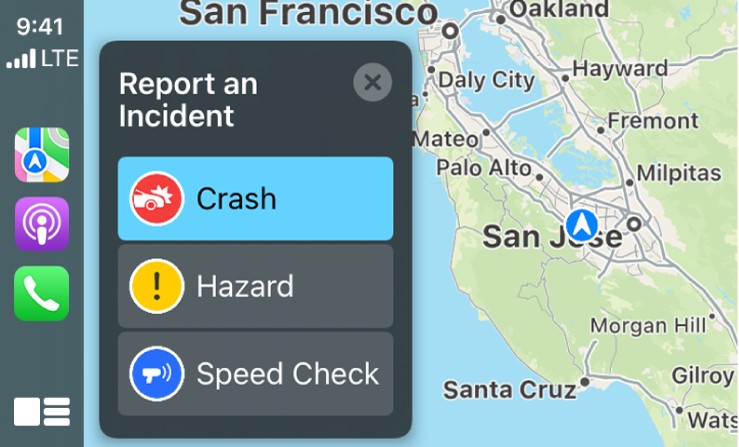
What do you think about Tesla Raj’s list? Be sure to let him know on Twitter @tesla_raj, and be sure to comment your thoughts below.

News
Tesla Diner defies the ‘Doom’ narrative: Profitable, Popular, and Here to Stay

The Tesla Diner has been subject to many points of criticism since its launch in mid-2025, and skeptics and disbelievers claim the company’s latest novel concept is on its way down, but there’s a lot of evidence to state that is not the case.
The piece cites anecdotal evidence like empty parking lots, more staff than customers during a December visit, removed novelty items, like Optimus robot popcorn service and certain menu items, the departure of celebrity chef Eric Greenspan in November 2025, slow service, high prices, and a shift in recent Google/Yelp reviews toward disappointment.
The piece frames this as part of broader Tesla struggles, including sales figures and Elon Musk’s polarizing image, calling it a failed branding exercise rather than a sustainable restaurant.
This narrative is overstated and sensationalized, and is a good representation of coverage on Tesla by today’s media.
Novelty Fade is Normal, Not Failure
Any hyped launch, especially a unique Tesla-branded destination blending dining, Supercharging, and a drive-in theater, naturally sees initial crowds taper off after the “Instagram effect” wears down.
Tesla makes major change at Supercharger Diner amid epic demand
This is common for experiential spots in Los Angeles, especially pop-up attractions or celebrity-backed venues. The article admits early success with massive lines and social media buzz, but treats the return to normal operations as “dying down.”
In reality, this stabilization is a healthy sign of transitioning from hype-driven traffic to steady patronage.
Actual Performance Metrics Contradict “Ghost Town” Claims
- In Q4 2025, the Diner generated over $1 million in revenue, exceeding the average McDonald’s location
- It sold over 30,000 burgers and 83,000 fries in that quarter alone. These figures indicate a strong ongoing business, especially for a single-location prototype focused on enhancing Supercharger experiences rather than competing as a mass-market chain
It’s not a ghost town lol. The @Tesla Diner still had over 30,000 burger orders and 83,000 fries orders in Q4. The diner generated over $1M in revenue in Q4, a $4M annual run rate, which is more than the average McDonald’s…. pic.twitter.com/XvAGLUqxej
— Sawyer Merritt (@SawyerMerritt) January 4, 2026
Conflicting On-the-Ground Reports
While the article, and other similar pieces, describe a half-full parking lot and sparse customers during specific off-peak visits, other recent accounts push back:
- A January 2026 X post noted 50 of 80 Supercharger stalls were busy at 11 a.m., calling it “the busiest diner in Hollywood by close to an order of magnitude
TESLA DINER 🍔
Frantic!!!
Crazy busy. pic.twitter.com/wMbmr8SFFn
— Rich & Sharon (@HullTeslaModel3) January 4, 2026
- Reddit discussions around the same time describe it as not empty when locals drive by regularly, with some calling the empty narrative “disingenuous anti-Tesla slop.”
When we visited it last week it was packed. We had to wait to enter, get a table and go to the restroom. We were lucky to find a spot to charge.
— Rani G (@ranig) January 4, 2026
Bottom Line
The Tesla Diner, admittedly, is not the nonstop circus it was at launch–that was never sustainable or intended. But, it’s far from “dying” or an “empty pit stop.”
It functions as a successful prototype: boosting Supercharger usage, generating solid revenue, and serving as a branded amenity in the high-traffic EV market of Los Angeles.
News
Tesla stands to win big from potential adjustment to autonomous vehicle limitations
Enabling scale, innovation, and profitability in a sector that is growing quickly would benefit Tesla significantly, especially as it has established itself as a leader.

Tesla stands to be a big winner from a potential easing of limitations on autonomous vehicle development, as the United States government could back off from the restrictions placed on companies developing self-driving car programs.
The U.S. House Energy and Commerce subcommittee will hold a hearing later this month that will aim to accelerate the deployment of autonomous vehicles. There are several key proposals that could impact the development of self-driving cars and potentially accelerate the deployment of this technology across the country.
These key proposals include raising the NHTSA’s exemption cap from 2,500 to 90,000 vehicles per year per automaker, preempting state-level regulations on autonomous vehicle systems, and mandating NHTSA guidelines for calibrating advanced driver assistance systems (ADAS).
Congress, to this point, has been divided on AV rules, with past bills like the 2017 House-passed measure stalling in the Senate. Recent pushes come from automakers urging the Trump administration to act faster amid competition from Chinese companies.
Companies like Tesla, who launched a Robotaxi service in Austin and the Bay Area last year, and Alphabet’s Waymo are highlighted as potential beneficiaries from lighter sanctions on AV development.
The NHTSA recently pledged to adopt a quicker exemption review for autonomous vehicle companies, and supporters of self-driving tech argue this will boost U.S. innovation, while critics are concerned about safety and job risks.
How Tesla Could Benefit from the Proposed Legislation
Tesla, under CEO Elon Musk’s leadership, has positioned itself as a pioneer in autonomous driving technology with its Full Self-Driving software and ambitious Robotaxi plans, including the Cybercab, which was unveiled in late 2024.
The draft legislation under consideration by the U.S. House subcommittee could provide Tesla with significant advantages, potentially transforming its operational and financial landscape.
NHTSA Exemption Cap Increase
First, the proposed increase in the NHTSA exemption cap from 2,500 to 90,000 vehicles annually would allow Tesla to scale up development dramatically.
Currently, regulatory hurdles limit how many fully autonomous vehicles can hit the roads without exhaustive approvals. For Tesla, this means accelerating the rollout of its robotaxi fleet, which Musk envisions as a network of millions of vehicles generating recurring revenue through ride-hailing. With Tesla’s vast existing fleet of over 6 million vehicles equipped with FSD hardware, a higher cap could enable rapid conversion and deployment, turning parked cars into profit centers overnight.
Preempting State Regulations
A united Federal framework would be created if it could preempt State regulations, eliminating the patchwork of rules that currently complicate interstate operations. Tesla has faced scrutiny and restrictions in states like California, especially as it has faced harsh criticism through imposed testing limits.
A federal override of State-level rules would reduce legal battles, compliance costs, and delays, allowing Tesla to expand services nationwide more seamlessly.
This is crucial for Tesla’s growth strategy, as it operates in multiple markets and aims for a coast-to-coast Robotaxi network, competing directly with Waymo’s city-specific expansions.
Bringing Safety Standards to the Present Day
Innovation in the passenger transportation sector has continued to outpace both State and Federal-level legislation, which has caused a lag in the development of many things, most notably, self-driving technology.
Updating these outdated safety standards, especially waiving requirements for steering wheels or mirrors, directly benefits Tesla’s innovative designs. Tesla wanted to ship Cybertruck without side mirrors, but Federal regulations required the company to equip the pickup with them.
Cybercab is also planned to be released without a steering wheel or pedals, and is tailored for full autonomy, but current rules would mandate human-ready features.
Streamlined NHTSA reviews would further expedite approvals, addressing Tesla’s complaints about bureaucratic slowdowns. In a letter written in June to the Trump Administration, automakers, including Tesla, urged faster action, and this legislation could deliver it.
In Summary
This legislation represents a potential regulatory tailwind for Tesla, but it still relies on the government to put forth action to make things easier from a regulatory perspective. Enabling scale, innovation, and profitability in a sector that is growing quickly would benefit Tesla significantly, especially as it has established itself as a leader.
News
Nvidia CEO Jensen Huang explains difference between Tesla FSD and Alpamayo
“Tesla’s FSD stack is completely world-class,” the Nvidia CEO said.

NVIDIA CEO Jensen Huang has offered high praise for Tesla’s Full Self-Driving (FSD) system during a Q&A at CES 2026, calling it “world-class” and “state-of-the-art” in design, training, and performance.
More importantly, he also shared some insights about the key differences between FSD and Nvidia’s recently announced Alpamayo system.
Jensen Huang’s praise for Tesla FSD
Nvidia made headlines at CES following its announcement of Alpamayo, which uses artificial intelligence to accelerate the development of autonomous driving solutions. Due to its focus on AI, many started speculating that Alpamayo would be a direct rival to FSD. This was somewhat addressed by Elon Musk, who predicted that “they will find that it’s easy to get to 99% and then super hard to solve the long tail of the distribution.”
During his Q&A, Nvidia CEO Jensen Huang was asked about the difference between FSD and Alpamayo. His response was extensive:
“Tesla’s FSD stack is completely world-class. They’ve been working on it for quite some time. It’s world-class not only in the number of miles it’s accumulated, but in the way it’s designed, the way they do training, data collection, curation, synthetic data generation, and all of their simulation technologies.
“Of course, the latest generation is end-to-end Full Self-Driving—meaning it’s one large model trained end to end. And so… Elon’s AD system is, in every way, 100% state-of-the-art. I’m really quite impressed by the technology. I have it, and I drive it in our house, and it works incredibly well,” the Nvidia CEO said.
Nvidia’s platform approach vs Tesla’s integration
Huang also stated that Nvidia’s Alpamayo system was built around a fundamentally different philosophy from Tesla’s. Rather than developing self-driving cars itself, Nvidia supplies the full autonomous technology stack for other companies to use.
“Nvidia doesn’t build self-driving cars. We build the full stack so others can,” Huang said, explaining that Nvidia provides separate systems for training, simulation, and in-vehicle computing, all supported by shared software.
He added that customers can adopt as much or as little of the platform as they need, noting that Nvidia works across the industry, including with Tesla on training systems and companies like Waymo, XPeng, and Nuro on vehicle computing.
“So our system is really quite pervasive because we’re a technology platform provider. That’s the primary difference. There’s no question in our mind that, of the billion cars on the road today, in another 10 years’ time, hundreds of millions of them will have great autonomous capability. This is likely one of the largest, fastest-growing technology industries over the next decade.”
He also emphasized Nvidia’s open approach, saying the company open-sources its models and helps partners train their own systems. “We’re not a self-driving car company. We’re enabling the autonomous industry,” Huang said.
